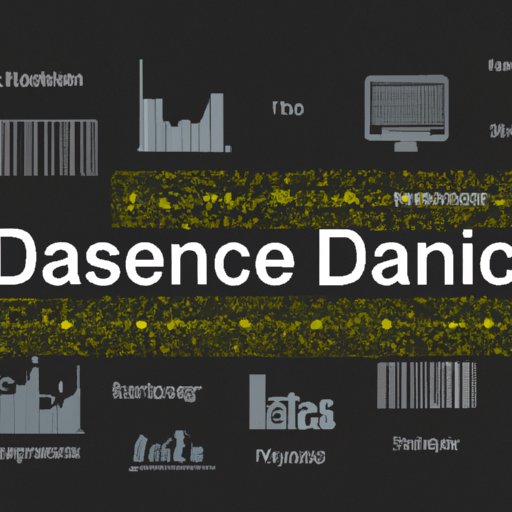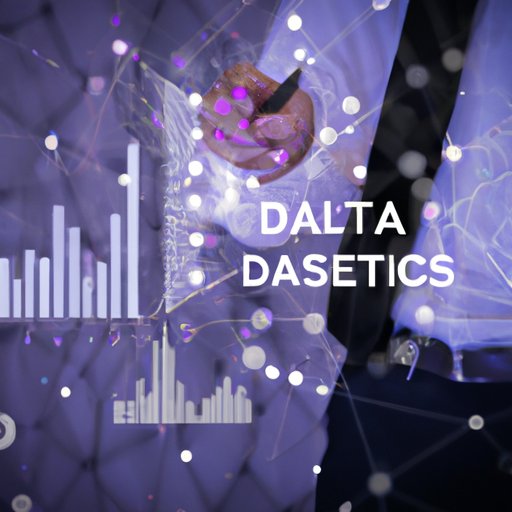Introduction
Data science and analytics are two of the most important fields in the modern world. They have become integral to many businesses and organizations, helping them to make better decisions, improve efficiency, and increase profitability. But what exactly are data science and analytics? And how can they be used to benefit companies? This article will explore these questions, providing an in-depth look at the basics, benefits, tools, and projects associated with the field.

Explaining the Basics of Data Science and Analytics
Data science is a field of study that involves analyzing large amounts of data to uncover patterns and draw conclusions. It combines elements of mathematics, computer science, and statistics to allow people to understand complex data sets and make informed decisions. Data scientists use a variety of techniques and tools to analyze data, such as machine learning algorithms, statistical analysis, and big data technologies. The goal of data science is to find insights that can be used to improve business operations, develop new products, and provide better customer experiences.
Analytics is the process of using data to answer questions about a particular subject. It involves collecting, organizing, and analyzing data to gain insights into trends, behaviors, and outcomes. Analytics can be used to measure performance, identify opportunities for improvement, and make predictions about the future. By understanding how different variables interact, companies can make more informed decisions and optimize their operations.

Exploring the Benefits of Data Science and Analytics
Data science and analytics can provide a wide range of benefits for organizations. Here are some of the most common advantages:
Improved Efficiency
Data science and analytics can help organizations become more efficient by allowing them to quickly identify and address areas of waste. By analyzing data, companies can pinpoint inefficiencies and develop strategies to address them. For example, a company might use analytics to determine which processes take the longest time and then use data science to automate them or streamline them.
Increased Profitability
Data science and analytics can also help companies increase their profits. By analyzing data, businesses can identify areas where they can save money or increase revenue. For instance, they may be able to identify customers who are likely to purchase additional products or services and target them with special offers. Companies can also use analytics to detect fraud and minimize losses.
Better Decision Making
Data science and analytics can help companies make better decisions. By analyzing data, companies can uncover insights that can inform their decision-making processes. For example, they may be able to identify which products or services are most popular with customers and adjust their marketing strategies accordingly. Companies can also use analytics to anticipate customer needs and develop new products or services to meet those needs.
Examining the Tools and Techniques Used by Data Scientists
Data scientists use a variety of tools and techniques to analyze data. Here are some of the most commonly used methods:
Machine Learning Algorithms
Machine learning algorithms are used to identify patterns in data and make predictions about future events. These algorithms can be used to detect anomalies, recommend products or services, and make predictions about customer behavior. Examples of machine learning algorithms include neural networks, support vector machines, and decision trees.
Statistical Analysis
Statistical analysis is used to summarize data and draw inferences from it. It can be used to identify correlations between different variables and measure the impact of one variable on another. Common techniques include regression analysis, hypothesis testing, and correlation analysis.
Big Data Technologies
Big data technologies are used to process large amounts of data quickly and efficiently. Examples include Apache Hadoop, Apache Spark, and NoSQL databases. These technologies allow data scientists to analyze data in real-time and uncover hidden insights that would otherwise remain undiscovered.
Profiling Successful Data Science & Analytics Projects
Data science and analytics have been used to great effect in a number of successful projects. Here are three examples of how data science and analytics have been used to drive growth and innovation:
Case Study: Netflix
Netflix has used data science and analytics to revolutionize the entertainment industry. By leveraging data, Netflix has been able to offer personalized content recommendations and develop original shows that appeal to its customers. The company has also used data to optimize its marketing campaigns and reduce churn rates.
Case Study: Spotify
Spotify has used data science and analytics to create a personalized music experience for its users. The company uses machine learning algorithms to make song recommendations and curate playlists. Spotify has also used analytics to track user behavior and optimize its product offering.
Case Study: Uber
Uber has used data science and analytics to revolutionize the transportation industry. The company uses analytics to match riders with drivers, optimize routes, and predict demand. Uber has also used data to improve safety and security measures, as well as to develop its self-driving car technology.

Investigating the Future of Data Science and Analytics
Data science and analytics are evolving rapidly, and there are a number of exciting developments on the horizon. Here are some of the most promising areas of research:
Predictive Modeling
Predictive modeling is a technique used to forecast future events. It involves using machine learning algorithms to identify patterns in data and make predictions about future outcomes. Predictive models can be used to anticipate customer needs, detect fraud, and predict demand.
Automation
Automation is the process of using machines to carry out tasks without human intervention. Automation can be used to streamline processes, reduce costs, and improve accuracy. For example, automation can be used to analyze large amounts of data quickly and accurately.
Artificial Intelligence
Artificial intelligence (AI) is the field of computer science that focuses on creating intelligent machines. AI can be used to automate processes, make predictions, and optimize operations. For example, AI can be used to analyze customer data and recommend products or services that are likely to be of interest.
Conclusion
Data science and analytics are powerful tools that can be used to improve efficiency, increase profitability, and make better decisions. They involve a variety of tools and techniques, such as machine learning algorithms, statistical analysis, and big data technologies. Data science and analytics have been used to great effect in a number of successful projects, such as Netflix, Spotify, and Uber. As the field continues to evolve, we can expect to see even more exciting developments in predictive modeling, automation, and artificial intelligence.
This article provided an overview of data science and analytics, exploring the basics, benefits, tools, and projects associated with the field. It examined the current state of the field and looked ahead to the future of data science and analytics. With the right knowledge and tools, companies can use data science and analytics to make informed decisions, optimize operations, and drive growth.
Resources for Further Reading
If you’d like to learn more about data science and analytics, here are some resources to check out:
- What Is Data Science? The Most In-Depth Answer You Will Find
- What Is Data Analytics? A Comprehensive Guide
- A Complete Tutorial to Learn Data Science for Beginners
- Top 15 Data Science Tools
Final Thoughts
Data science and analytics are transforming the way companies do business. By leveraging data, companies can make better decisions, improve efficiency, and increase profitability. With the right knowledge and tools, data science and analytics can be used to unlock new insights and drive growth.
(Note: Is this article not meeting your expectations? Do you have knowledge or insights to share? Unlock new opportunities and expand your reach by joining our authors team. Click Registration to join us and share your expertise with our readers.)
